In-Depth Analysis of OpenEMR: A Review of Features and Usability
VerifiedAdded on 2023/06/11
|29
|5525
|128
Report
AI Summary
This report provides a comprehensive analysis of OpenEMR, an open-source electronic medical record (EMR) system, examining its features, usability, and implementation in healthcare settings. It begins with an introduction to OpenEMR, detailing its history, user base, and clinical features such as basic appearance, note creation, paper management, billing integration, database structure, prescribing module, and problem lists. The report further explores the development of features within the OpenEMR community, highlighting the collaborative approach to enhancements. A practical guide on using OpenEMR is included, covering creating new patient profiles, adding insurance information, and scheduling patient visits. The report concludes with a detailed usability analysis, evaluating learnability, efficiency, error handling, satisfaction, and memorability, providing a thorough assessment of OpenEMR's effectiveness and user-friendliness in clinical practice. This document is available on Desklib, a platform offering a wide range of study tools and resources for students.
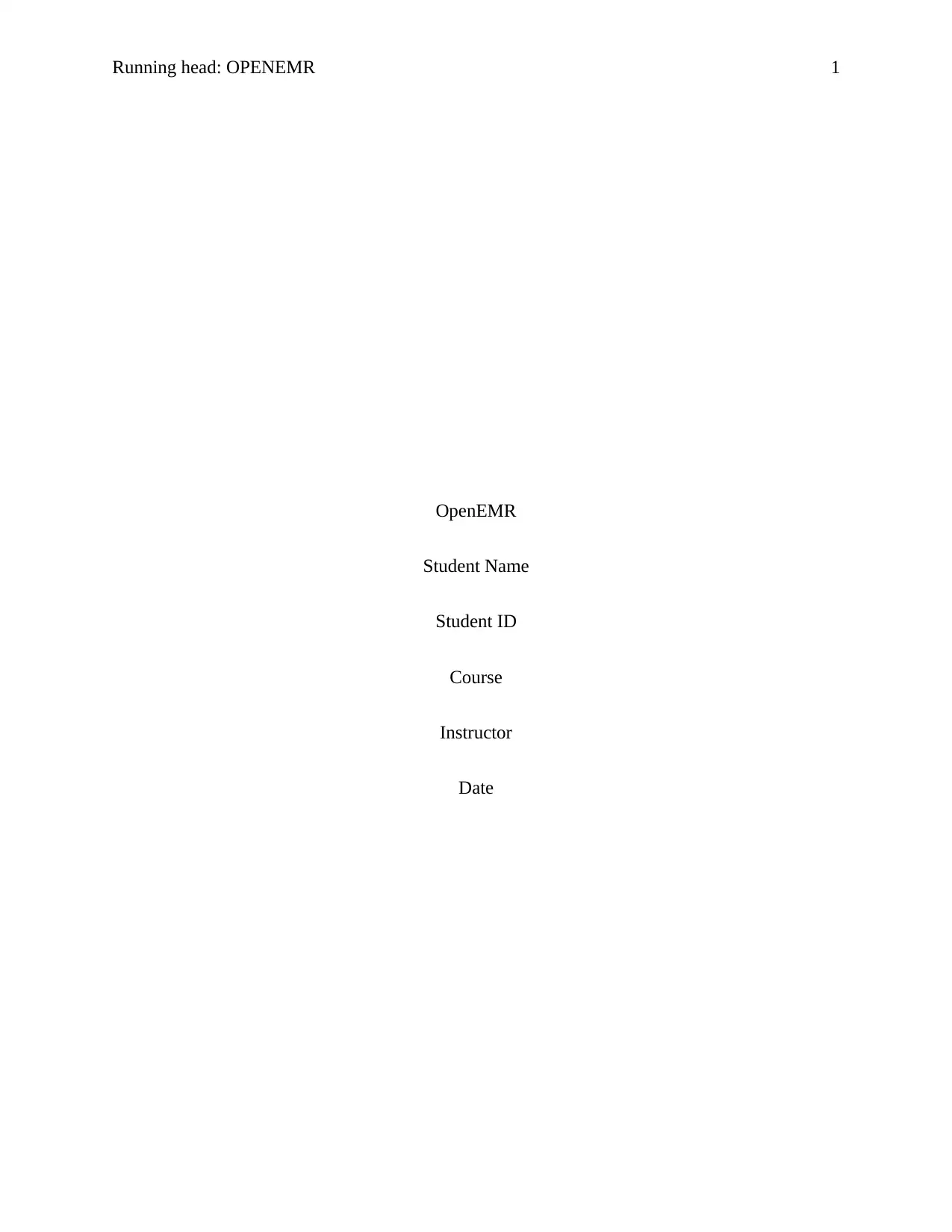
Running head: OPENEMR 1
OpenEMR
Student Name
Student ID
Course
Instructor
Date
OpenEMR
Student Name
Student ID
Course
Instructor
Date
Paraphrase This Document
Need a fresh take? Get an instant paraphrase of this document with our AI Paraphraser
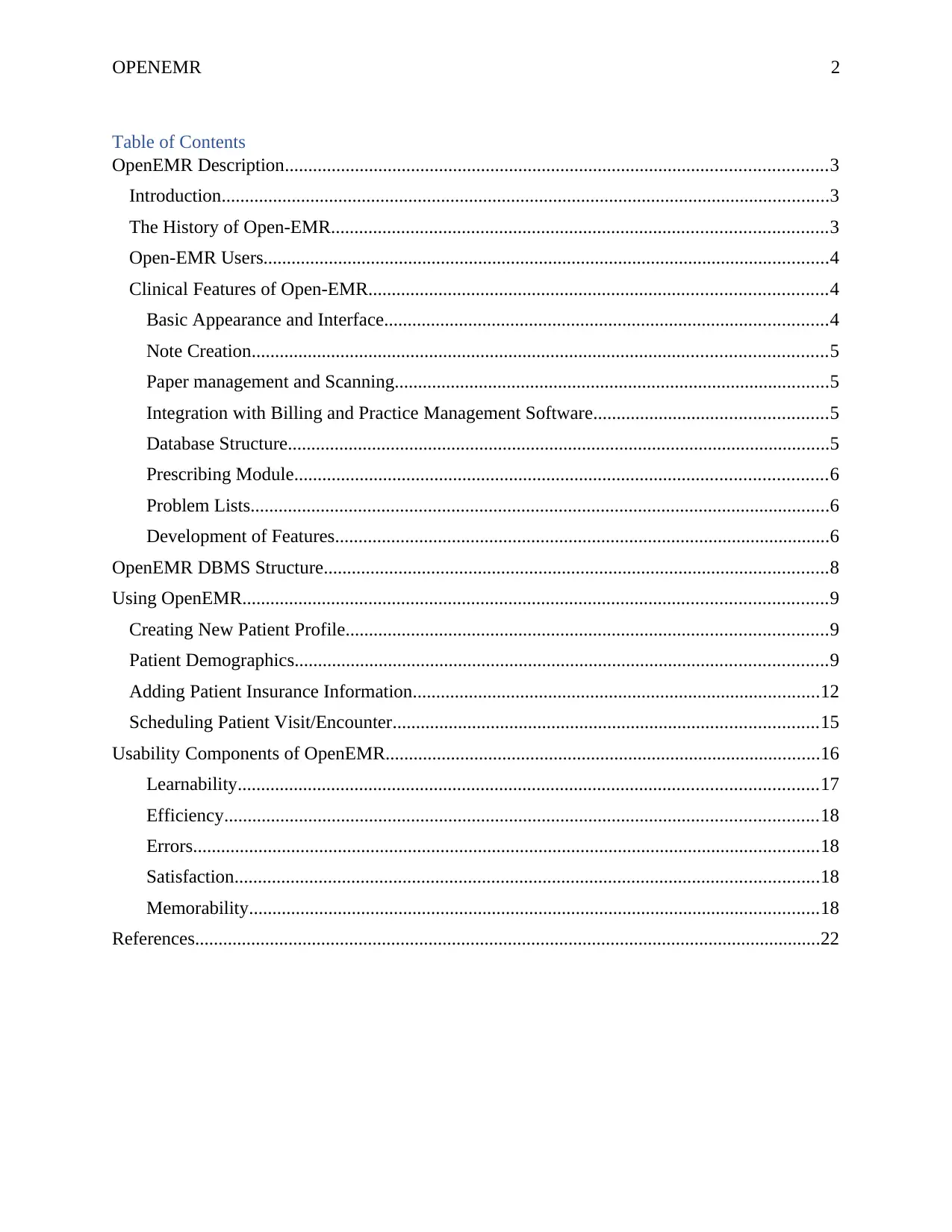
OPENEMR 2
Table of Contents
OpenEMR Description....................................................................................................................3
Introduction..................................................................................................................................3
The History of Open-EMR..........................................................................................................3
Open-EMR Users.........................................................................................................................4
Clinical Features of Open-EMR..................................................................................................4
Basic Appearance and Interface...............................................................................................4
Note Creation...........................................................................................................................5
Paper management and Scanning.............................................................................................5
Integration with Billing and Practice Management Software..................................................5
Database Structure....................................................................................................................5
Prescribing Module..................................................................................................................6
Problem Lists............................................................................................................................6
Development of Features..........................................................................................................6
OpenEMR DBMS Structure............................................................................................................8
Using OpenEMR.............................................................................................................................9
Creating New Patient Profile.......................................................................................................9
Patient Demographics..................................................................................................................9
Adding Patient Insurance Information.......................................................................................12
Scheduling Patient Visit/Encounter...........................................................................................15
Usability Components of OpenEMR.............................................................................................16
Learnability............................................................................................................................17
Efficiency...............................................................................................................................18
Errors......................................................................................................................................18
Satisfaction.............................................................................................................................18
Memorability..........................................................................................................................18
References......................................................................................................................................22
Table of Contents
OpenEMR Description....................................................................................................................3
Introduction..................................................................................................................................3
The History of Open-EMR..........................................................................................................3
Open-EMR Users.........................................................................................................................4
Clinical Features of Open-EMR..................................................................................................4
Basic Appearance and Interface...............................................................................................4
Note Creation...........................................................................................................................5
Paper management and Scanning.............................................................................................5
Integration with Billing and Practice Management Software..................................................5
Database Structure....................................................................................................................5
Prescribing Module..................................................................................................................6
Problem Lists............................................................................................................................6
Development of Features..........................................................................................................6
OpenEMR DBMS Structure............................................................................................................8
Using OpenEMR.............................................................................................................................9
Creating New Patient Profile.......................................................................................................9
Patient Demographics..................................................................................................................9
Adding Patient Insurance Information.......................................................................................12
Scheduling Patient Visit/Encounter...........................................................................................15
Usability Components of OpenEMR.............................................................................................16
Learnability............................................................................................................................17
Efficiency...............................................................................................................................18
Errors......................................................................................................................................18
Satisfaction.............................................................................................................................18
Memorability..........................................................................................................................18
References......................................................................................................................................22
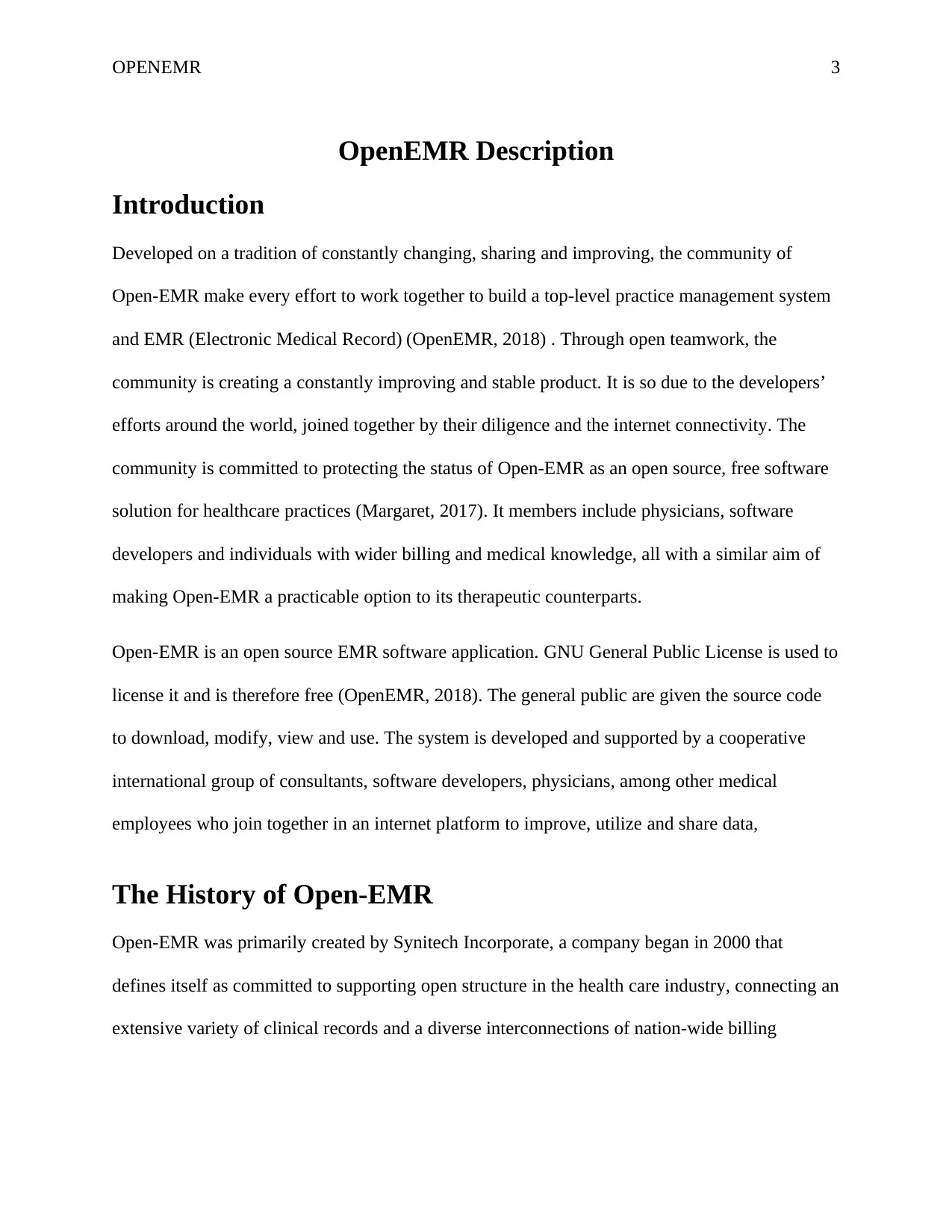
OPENEMR 3
OpenEMR Description
Introduction
Developed on a tradition of constantly changing, sharing and improving, the community of
Open-EMR make every effort to work together to build a top-level practice management system
and EMR (Electronic Medical Record) (OpenEMR, 2018) . Through open teamwork, the
community is creating a constantly improving and stable product. It is so due to the developers’
efforts around the world, joined together by their diligence and the internet connectivity. The
community is committed to protecting the status of Open-EMR as an open source, free software
solution for healthcare practices (Margaret, 2017). It members include physicians, software
developers and individuals with wider billing and medical knowledge, all with a similar aim of
making Open-EMR a practicable option to its therapeutic counterparts.
Open-EMR is an open source EMR software application. GNU General Public License is used to
license it and is therefore free (OpenEMR, 2018). The general public are given the source code
to download, modify, view and use. The system is developed and supported by a cooperative
international group of consultants, software developers, physicians, among other medical
employees who join together in an internet platform to improve, utilize and share data,
The History of Open-EMR
Open-EMR was primarily created by Synitech Incorporate, a company began in 2000 that
defines itself as committed to supporting open structure in the health care industry, connecting an
extensive variety of clinical records and a diverse interconnections of nation-wide billing
OpenEMR Description
Introduction
Developed on a tradition of constantly changing, sharing and improving, the community of
Open-EMR make every effort to work together to build a top-level practice management system
and EMR (Electronic Medical Record) (OpenEMR, 2018) . Through open teamwork, the
community is creating a constantly improving and stable product. It is so due to the developers’
efforts around the world, joined together by their diligence and the internet connectivity. The
community is committed to protecting the status of Open-EMR as an open source, free software
solution for healthcare practices (Margaret, 2017). It members include physicians, software
developers and individuals with wider billing and medical knowledge, all with a similar aim of
making Open-EMR a practicable option to its therapeutic counterparts.
Open-EMR is an open source EMR software application. GNU General Public License is used to
license it and is therefore free (OpenEMR, 2018). The general public are given the source code
to download, modify, view and use. The system is developed and supported by a cooperative
international group of consultants, software developers, physicians, among other medical
employees who join together in an internet platform to improve, utilize and share data,
The History of Open-EMR
Open-EMR was primarily created by Synitech Incorporate, a company began in 2000 that
defines itself as committed to supporting open structure in the health care industry, connecting an
extensive variety of clinical records and a diverse interconnections of nation-wide billing
⊘ This is a preview!⊘
Do you want full access?
Subscribe today to unlock all pages.

Trusted by 1+ million students worldwide
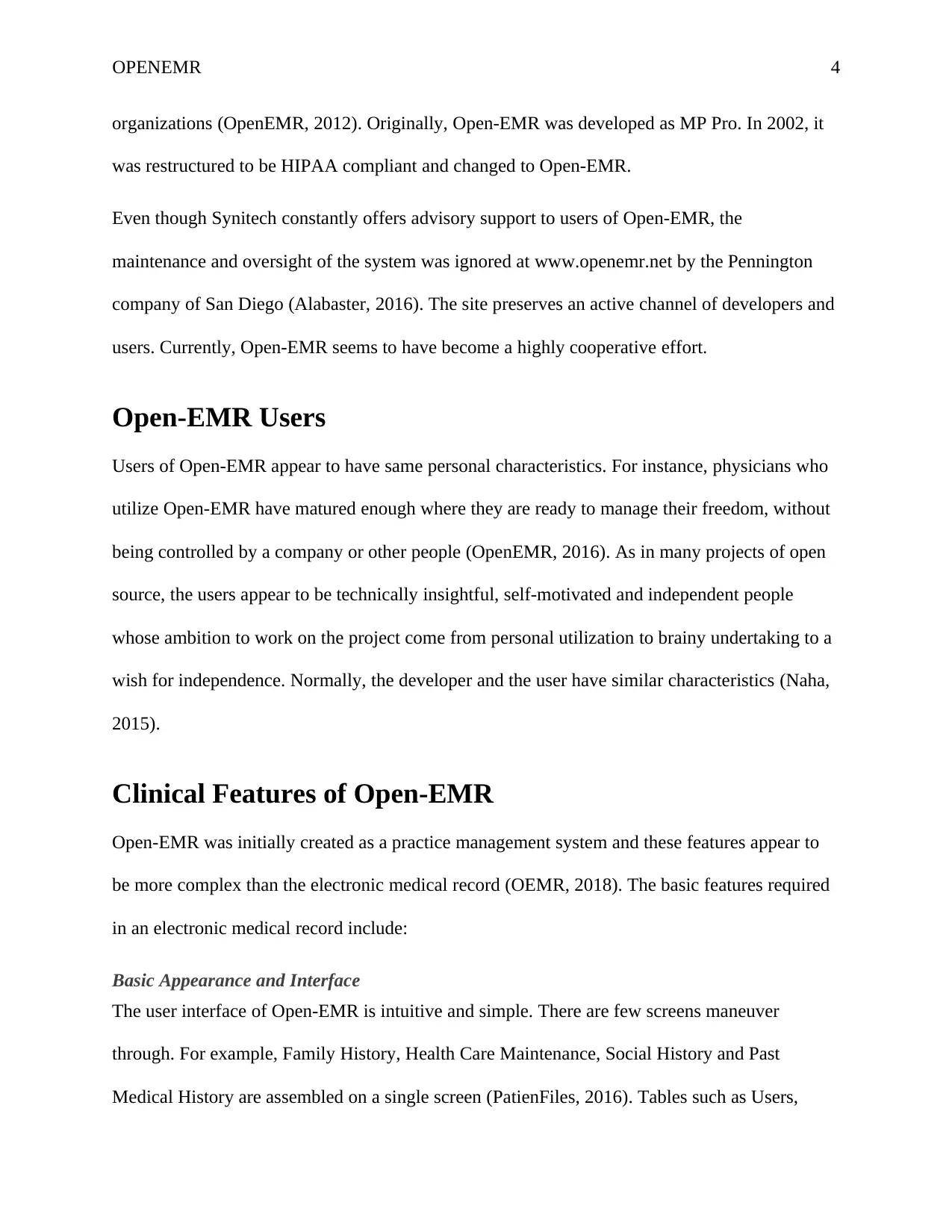
OPENEMR 4
organizations (OpenEMR, 2012). Originally, Open-EMR was developed as MP Pro. In 2002, it
was restructured to be HIPAA compliant and changed to Open-EMR.
Even though Synitech constantly offers advisory support to users of Open-EMR, the
maintenance and oversight of the system was ignored at www.openemr.net by the Pennington
company of San Diego (Alabaster, 2016). The site preserves an active channel of developers and
users. Currently, Open-EMR seems to have become a highly cooperative effort.
Open-EMR Users
Users of Open-EMR appear to have same personal characteristics. For instance, physicians who
utilize Open-EMR have matured enough where they are ready to manage their freedom, without
being controlled by a company or other people (OpenEMR, 2016). As in many projects of open
source, the users appear to be technically insightful, self-motivated and independent people
whose ambition to work on the project come from personal utilization to brainy undertaking to a
wish for independence. Normally, the developer and the user have similar characteristics (Naha,
2015).
Clinical Features of Open-EMR
Open-EMR was initially created as a practice management system and these features appear to
be more complex than the electronic medical record (OEMR, 2018). The basic features required
in an electronic medical record include:
Basic Appearance and Interface
The user interface of Open-EMR is intuitive and simple. There are few screens maneuver
through. For example, Family History, Health Care Maintenance, Social History and Past
Medical History are assembled on a single screen (PatienFiles, 2016). Tables such as Users,
organizations (OpenEMR, 2012). Originally, Open-EMR was developed as MP Pro. In 2002, it
was restructured to be HIPAA compliant and changed to Open-EMR.
Even though Synitech constantly offers advisory support to users of Open-EMR, the
maintenance and oversight of the system was ignored at www.openemr.net by the Pennington
company of San Diego (Alabaster, 2016). The site preserves an active channel of developers and
users. Currently, Open-EMR seems to have become a highly cooperative effort.
Open-EMR Users
Users of Open-EMR appear to have same personal characteristics. For instance, physicians who
utilize Open-EMR have matured enough where they are ready to manage their freedom, without
being controlled by a company or other people (OpenEMR, 2016). As in many projects of open
source, the users appear to be technically insightful, self-motivated and independent people
whose ambition to work on the project come from personal utilization to brainy undertaking to a
wish for independence. Normally, the developer and the user have similar characteristics (Naha,
2015).
Clinical Features of Open-EMR
Open-EMR was initially created as a practice management system and these features appear to
be more complex than the electronic medical record (OEMR, 2018). The basic features required
in an electronic medical record include:
Basic Appearance and Interface
The user interface of Open-EMR is intuitive and simple. There are few screens maneuver
through. For example, Family History, Health Care Maintenance, Social History and Past
Medical History are assembled on a single screen (PatienFiles, 2016). Tables such as Users,
Paraphrase This Document
Need a fresh take? Get an instant paraphrase of this document with our AI Paraphraser
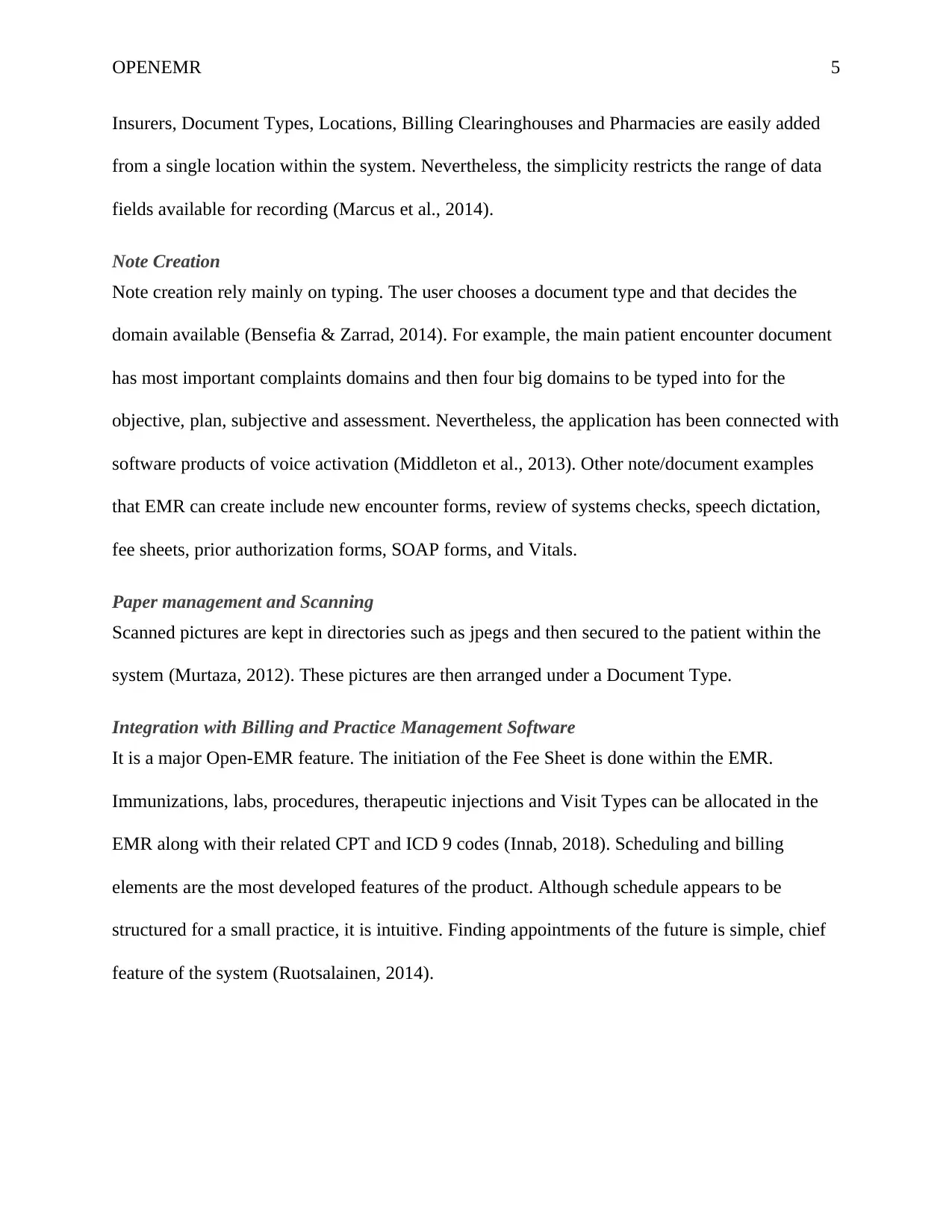
OPENEMR 5
Insurers, Document Types, Locations, Billing Clearinghouses and Pharmacies are easily added
from a single location within the system. Nevertheless, the simplicity restricts the range of data
fields available for recording (Marcus et al., 2014).
Note Creation
Note creation rely mainly on typing. The user chooses a document type and that decides the
domain available (Bensefia & Zarrad, 2014). For example, the main patient encounter document
has most important complaints domains and then four big domains to be typed into for the
objective, plan, subjective and assessment. Nevertheless, the application has been connected with
software products of voice activation (Middleton et al., 2013). Other note/document examples
that EMR can create include new encounter forms, review of systems checks, speech dictation,
fee sheets, prior authorization forms, SOAP forms, and Vitals.
Paper management and Scanning
Scanned pictures are kept in directories such as jpegs and then secured to the patient within the
system (Murtaza, 2012). These pictures are then arranged under a Document Type.
Integration with Billing and Practice Management Software
It is a major Open-EMR feature. The initiation of the Fee Sheet is done within the EMR.
Immunizations, labs, procedures, therapeutic injections and Visit Types can be allocated in the
EMR along with their related CPT and ICD 9 codes (Innab, 2018). Scheduling and billing
elements are the most developed features of the product. Although schedule appears to be
structured for a small practice, it is intuitive. Finding appointments of the future is simple, chief
feature of the system (Ruotsalainen, 2014).
Insurers, Document Types, Locations, Billing Clearinghouses and Pharmacies are easily added
from a single location within the system. Nevertheless, the simplicity restricts the range of data
fields available for recording (Marcus et al., 2014).
Note Creation
Note creation rely mainly on typing. The user chooses a document type and that decides the
domain available (Bensefia & Zarrad, 2014). For example, the main patient encounter document
has most important complaints domains and then four big domains to be typed into for the
objective, plan, subjective and assessment. Nevertheless, the application has been connected with
software products of voice activation (Middleton et al., 2013). Other note/document examples
that EMR can create include new encounter forms, review of systems checks, speech dictation,
fee sheets, prior authorization forms, SOAP forms, and Vitals.
Paper management and Scanning
Scanned pictures are kept in directories such as jpegs and then secured to the patient within the
system (Murtaza, 2012). These pictures are then arranged under a Document Type.
Integration with Billing and Practice Management Software
It is a major Open-EMR feature. The initiation of the Fee Sheet is done within the EMR.
Immunizations, labs, procedures, therapeutic injections and Visit Types can be allocated in the
EMR along with their related CPT and ICD 9 codes (Innab, 2018). Scheduling and billing
elements are the most developed features of the product. Although schedule appears to be
structured for a small practice, it is intuitive. Finding appointments of the future is simple, chief
feature of the system (Ruotsalainen, 2014).
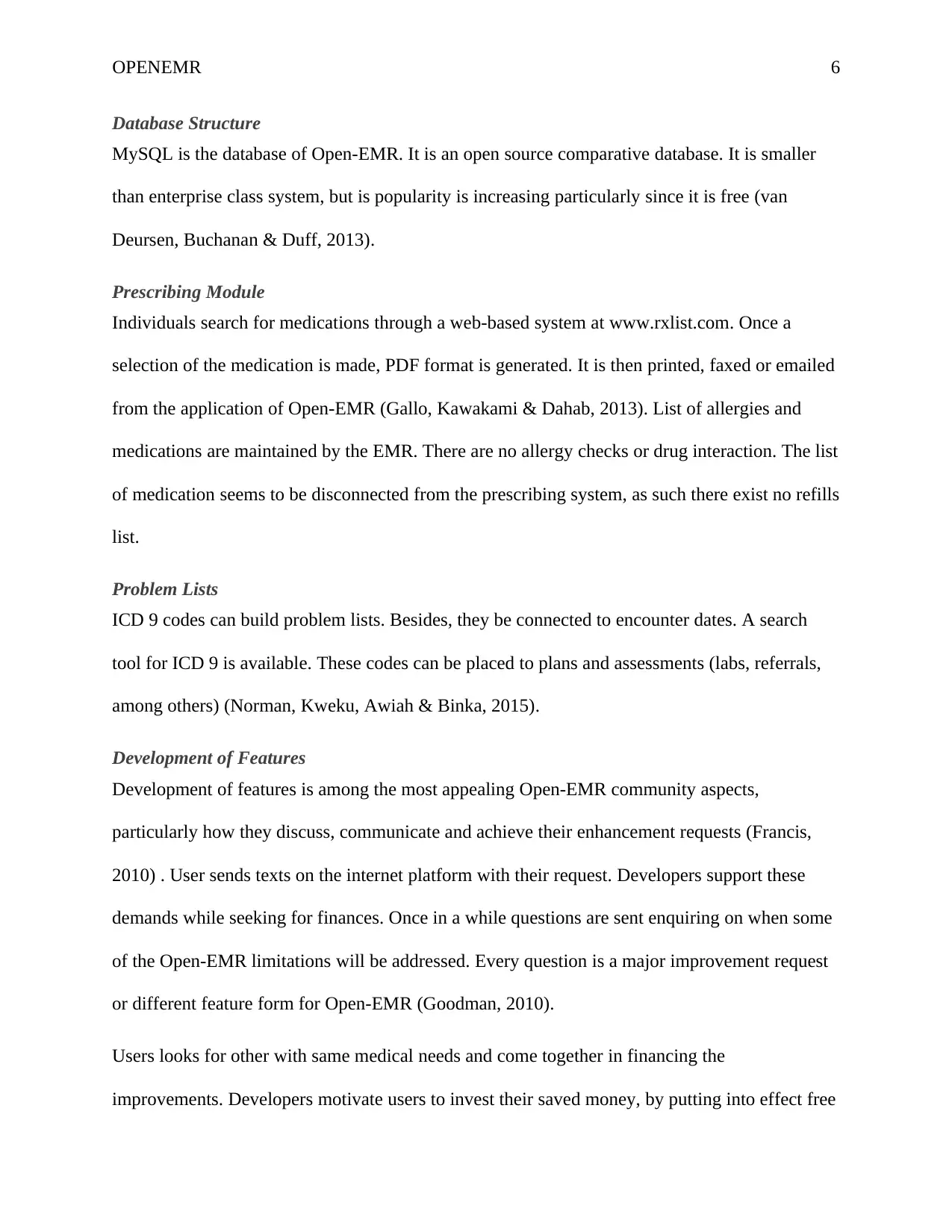
OPENEMR 6
Database Structure
MySQL is the database of Open-EMR. It is an open source comparative database. It is smaller
than enterprise class system, but is popularity is increasing particularly since it is free (van
Deursen, Buchanan & Duff, 2013).
Prescribing Module
Individuals search for medications through a web-based system at www.rxlist.com. Once a
selection of the medication is made, PDF format is generated. It is then printed, faxed or emailed
from the application of Open-EMR (Gallo, Kawakami & Dahab, 2013). List of allergies and
medications are maintained by the EMR. There are no allergy checks or drug interaction. The list
of medication seems to be disconnected from the prescribing system, as such there exist no refills
list.
Problem Lists
ICD 9 codes can build problem lists. Besides, they be connected to encounter dates. A search
tool for ICD 9 is available. These codes can be placed to plans and assessments (labs, referrals,
among others) (Norman, Kweku, Awiah & Binka, 2015).
Development of Features
Development of features is among the most appealing Open-EMR community aspects,
particularly how they discuss, communicate and achieve their enhancement requests (Francis,
2010) . User sends texts on the internet platform with their request. Developers support these
demands while seeking for finances. Once in a while questions are sent enquiring on when some
of the Open-EMR limitations will be addressed. Every question is a major improvement request
or different feature form for Open-EMR (Goodman, 2010).
Users looks for other with same medical needs and come together in financing the
improvements. Developers motivate users to invest their saved money, by putting into effect free
Database Structure
MySQL is the database of Open-EMR. It is an open source comparative database. It is smaller
than enterprise class system, but is popularity is increasing particularly since it is free (van
Deursen, Buchanan & Duff, 2013).
Prescribing Module
Individuals search for medications through a web-based system at www.rxlist.com. Once a
selection of the medication is made, PDF format is generated. It is then printed, faxed or emailed
from the application of Open-EMR (Gallo, Kawakami & Dahab, 2013). List of allergies and
medications are maintained by the EMR. There are no allergy checks or drug interaction. The list
of medication seems to be disconnected from the prescribing system, as such there exist no refills
list.
Problem Lists
ICD 9 codes can build problem lists. Besides, they be connected to encounter dates. A search
tool for ICD 9 is available. These codes can be placed to plans and assessments (labs, referrals,
among others) (Norman, Kweku, Awiah & Binka, 2015).
Development of Features
Development of features is among the most appealing Open-EMR community aspects,
particularly how they discuss, communicate and achieve their enhancement requests (Francis,
2010) . User sends texts on the internet platform with their request. Developers support these
demands while seeking for finances. Once in a while questions are sent enquiring on when some
of the Open-EMR limitations will be addressed. Every question is a major improvement request
or different feature form for Open-EMR (Goodman, 2010).
Users looks for other with same medical needs and come together in financing the
improvements. Developers motivate users to invest their saved money, by putting into effect free
⊘ This is a preview!⊘
Do you want full access?
Subscribe today to unlock all pages.

Trusted by 1+ million students worldwide
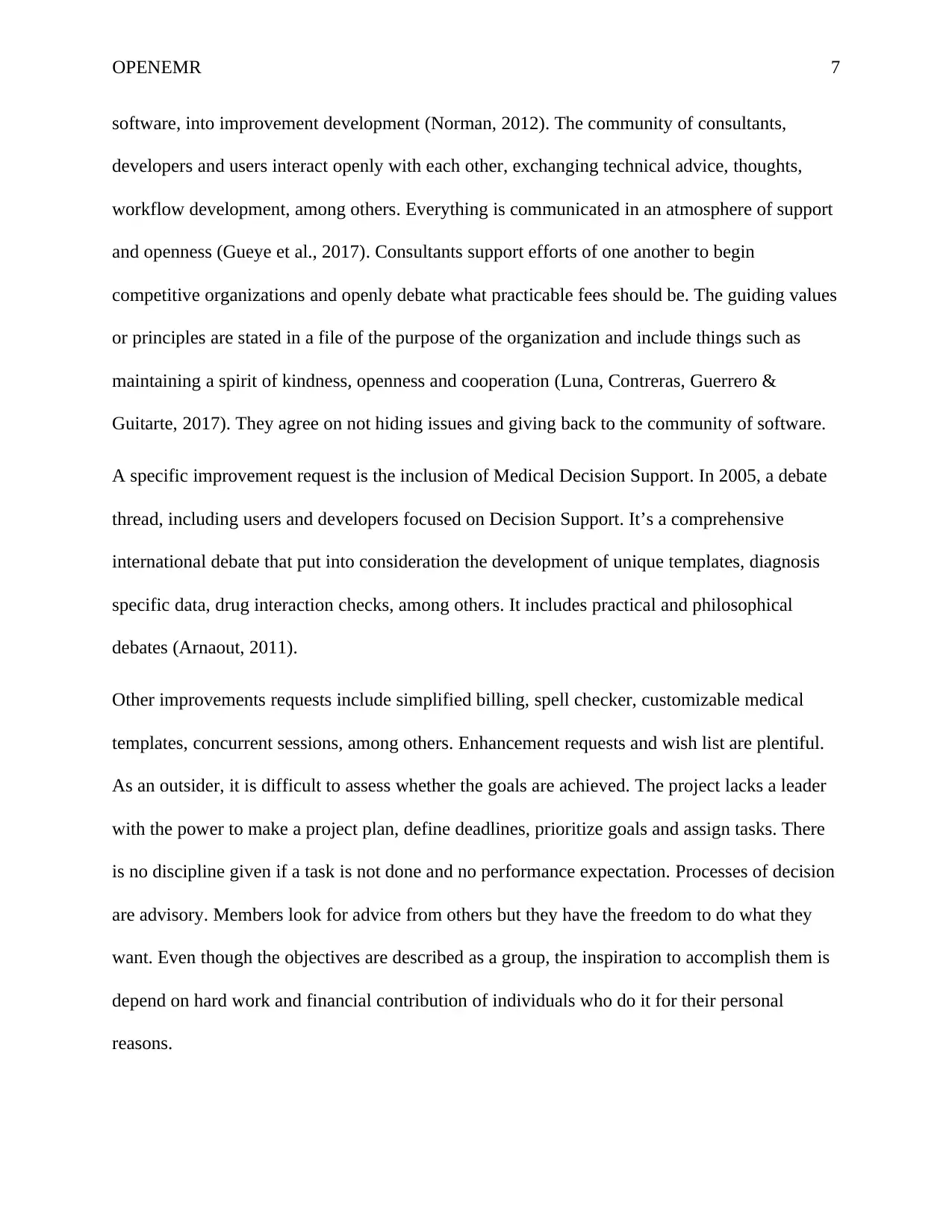
OPENEMR 7
software, into improvement development (Norman, 2012). The community of consultants,
developers and users interact openly with each other, exchanging technical advice, thoughts,
workflow development, among others. Everything is communicated in an atmosphere of support
and openness (Gueye et al., 2017). Consultants support efforts of one another to begin
competitive organizations and openly debate what practicable fees should be. The guiding values
or principles are stated in a file of the purpose of the organization and include things such as
maintaining a spirit of kindness, openness and cooperation (Luna, Contreras, Guerrero &
Guitarte, 2017). They agree on not hiding issues and giving back to the community of software.
A specific improvement request is the inclusion of Medical Decision Support. In 2005, a debate
thread, including users and developers focused on Decision Support. It’s a comprehensive
international debate that put into consideration the development of unique templates, diagnosis
specific data, drug interaction checks, among others. It includes practical and philosophical
debates (Arnaout, 2011).
Other improvements requests include simplified billing, spell checker, customizable medical
templates, concurrent sessions, among others. Enhancement requests and wish list are plentiful.
As an outsider, it is difficult to assess whether the goals are achieved. The project lacks a leader
with the power to make a project plan, define deadlines, prioritize goals and assign tasks. There
is no discipline given if a task is not done and no performance expectation. Processes of decision
are advisory. Members look for advice from others but they have the freedom to do what they
want. Even though the objectives are described as a group, the inspiration to accomplish them is
depend on hard work and financial contribution of individuals who do it for their personal
reasons.
software, into improvement development (Norman, 2012). The community of consultants,
developers and users interact openly with each other, exchanging technical advice, thoughts,
workflow development, among others. Everything is communicated in an atmosphere of support
and openness (Gueye et al., 2017). Consultants support efforts of one another to begin
competitive organizations and openly debate what practicable fees should be. The guiding values
or principles are stated in a file of the purpose of the organization and include things such as
maintaining a spirit of kindness, openness and cooperation (Luna, Contreras, Guerrero &
Guitarte, 2017). They agree on not hiding issues and giving back to the community of software.
A specific improvement request is the inclusion of Medical Decision Support. In 2005, a debate
thread, including users and developers focused on Decision Support. It’s a comprehensive
international debate that put into consideration the development of unique templates, diagnosis
specific data, drug interaction checks, among others. It includes practical and philosophical
debates (Arnaout, 2011).
Other improvements requests include simplified billing, spell checker, customizable medical
templates, concurrent sessions, among others. Enhancement requests and wish list are plentiful.
As an outsider, it is difficult to assess whether the goals are achieved. The project lacks a leader
with the power to make a project plan, define deadlines, prioritize goals and assign tasks. There
is no discipline given if a task is not done and no performance expectation. Processes of decision
are advisory. Members look for advice from others but they have the freedom to do what they
want. Even though the objectives are described as a group, the inspiration to accomplish them is
depend on hard work and financial contribution of individuals who do it for their personal
reasons.
Paraphrase This Document
Need a fresh take? Get an instant paraphrase of this document with our AI Paraphraser

OPENEMR 8
In spite of lack of normal hierarchies of project, open source works since many individuals join
together around a similar objective, have the ability as individuals to cause something to occur
and acknowledge that the more money and time they invest in the objective, the more likely they
will make something happen.
In spite of lack of normal hierarchies of project, open source works since many individuals join
together around a similar objective, have the ability as individuals to cause something to occur
and acknowledge that the more money and time they invest in the objective, the more likely they
will make something happen.
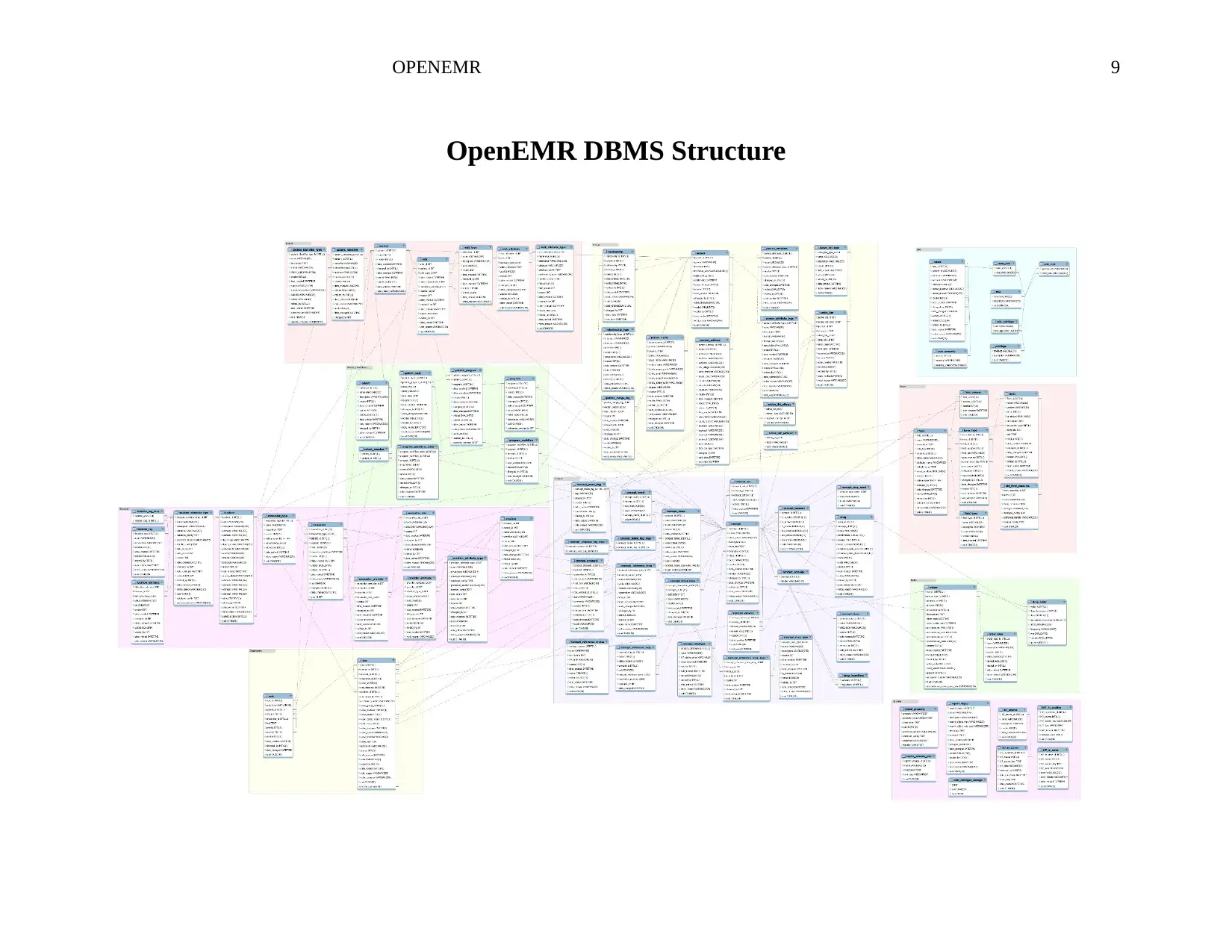
OPENEMR 9
OpenEMR DBMS Structure
OpenEMR DBMS Structure
⊘ This is a preview!⊘
Do you want full access?
Subscribe today to unlock all pages.

Trusted by 1+ million students worldwide
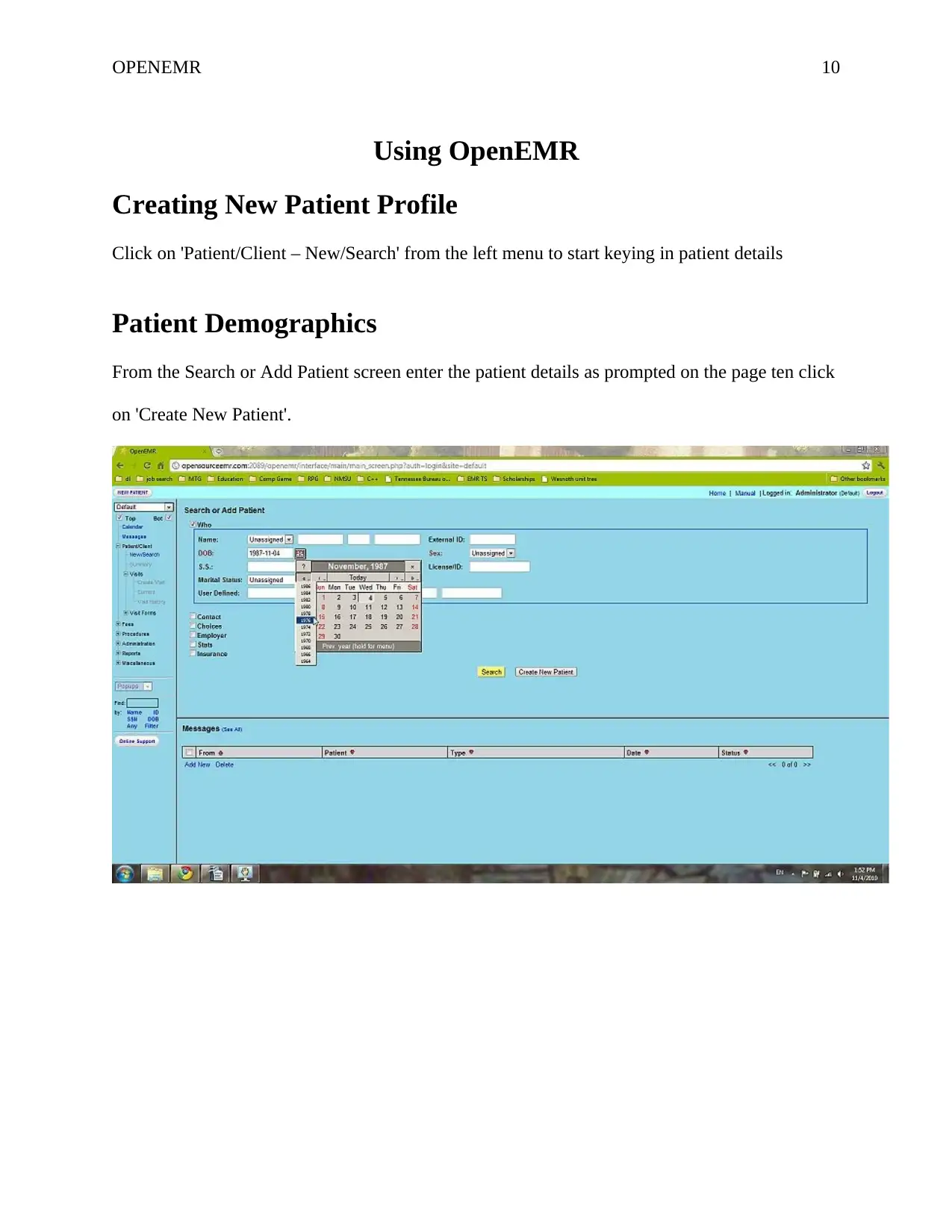
OPENEMR 10
Using OpenEMR
Creating New Patient Profile
Click on 'Patient/Client – New/Search' from the left menu to start keying in patient details
Patient Demographics
From the Search or Add Patient screen enter the patient details as prompted on the page ten click
on 'Create New Patient'.
Using OpenEMR
Creating New Patient Profile
Click on 'Patient/Client – New/Search' from the left menu to start keying in patient details
Patient Demographics
From the Search or Add Patient screen enter the patient details as prompted on the page ten click
on 'Create New Patient'.
Paraphrase This Document
Need a fresh take? Get an instant paraphrase of this document with our AI Paraphraser
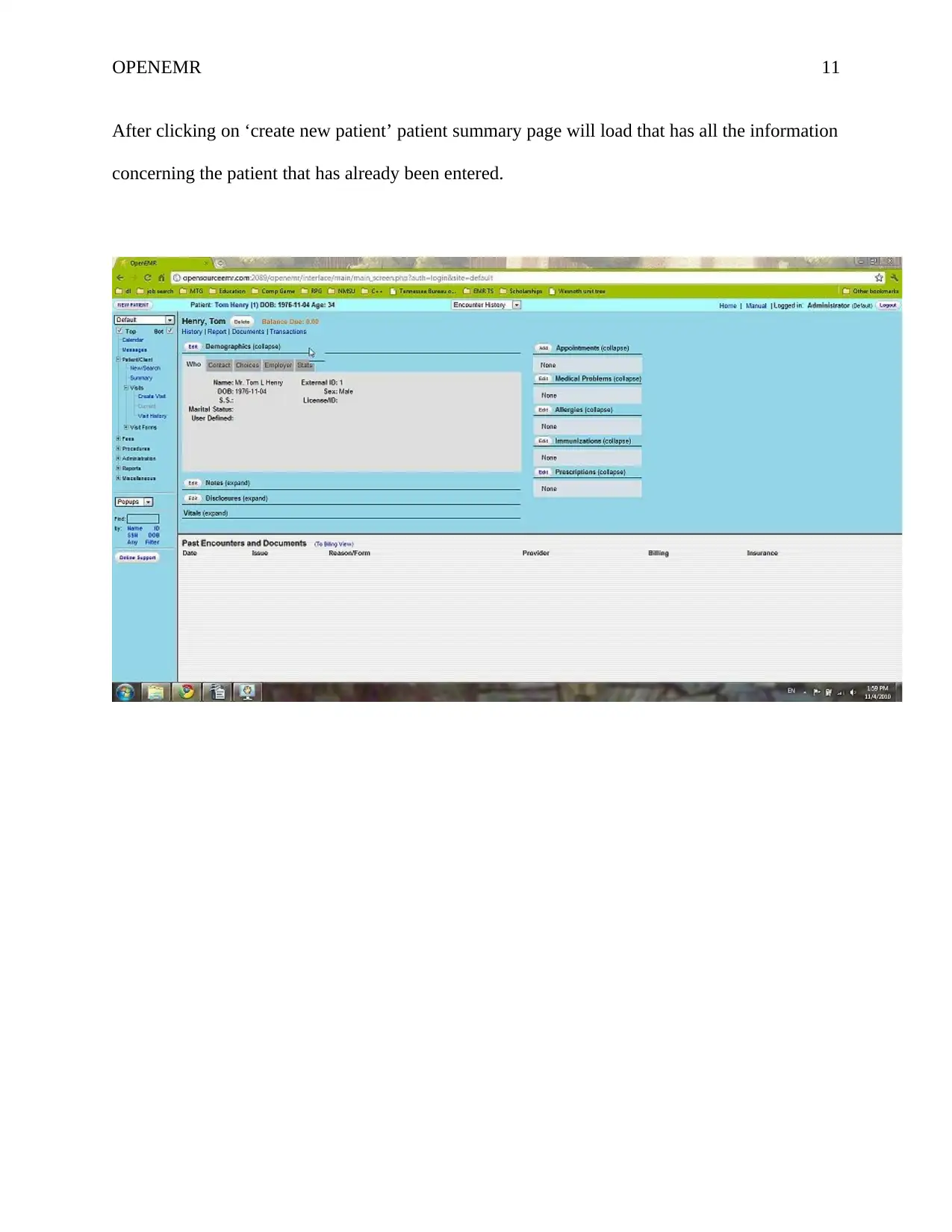
OPENEMR 11
After clicking on ‘create new patient’ patient summary page will load that has all the information
concerning the patient that has already been entered.
After clicking on ‘create new patient’ patient summary page will load that has all the information
concerning the patient that has already been entered.
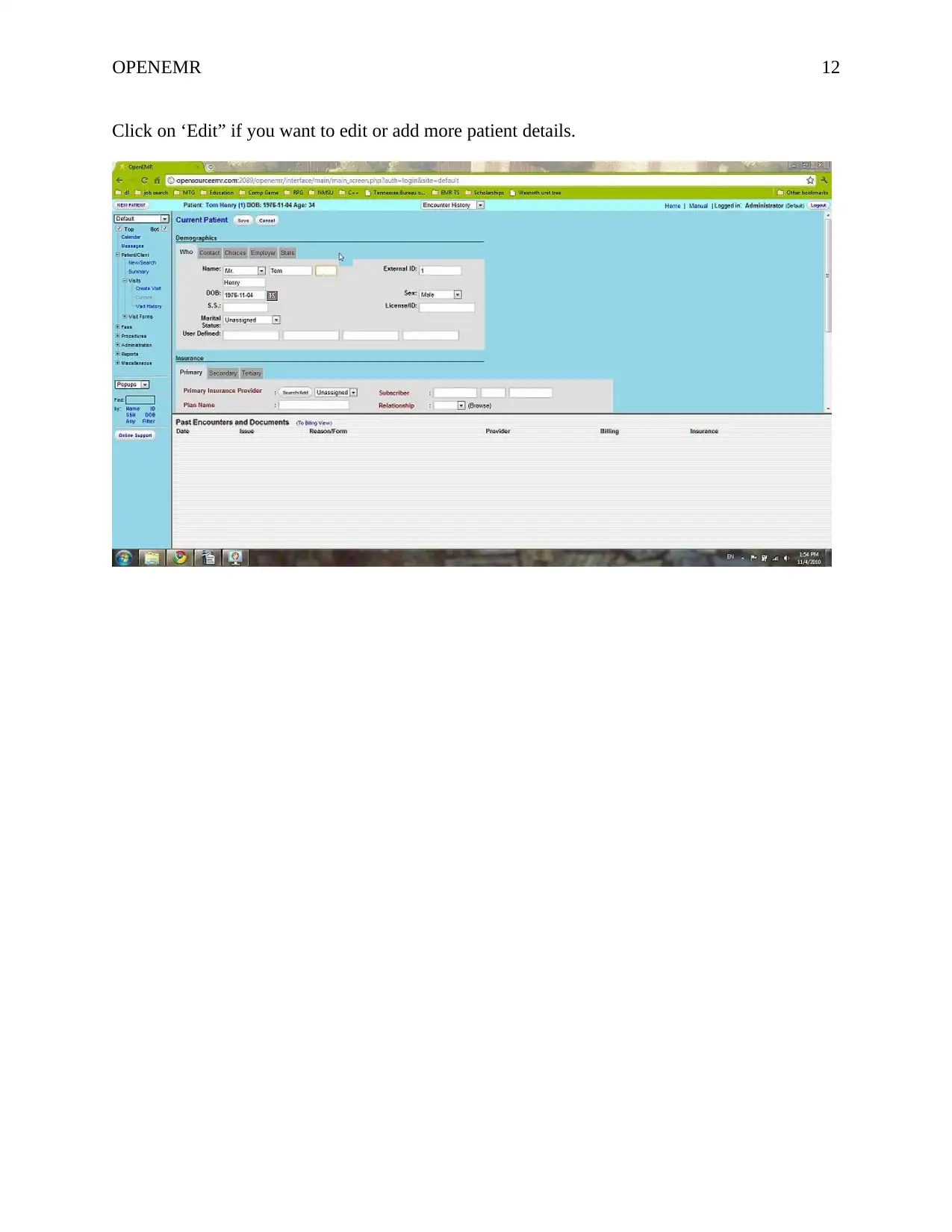
OPENEMR 12
Click on ‘Edit” if you want to edit or add more patient details.
Click on ‘Edit” if you want to edit or add more patient details.
⊘ This is a preview!⊘
Do you want full access?
Subscribe today to unlock all pages.

Trusted by 1+ million students worldwide
1 out of 29
Your All-in-One AI-Powered Toolkit for Academic Success.
+13062052269
info@desklib.com
Available 24*7 on WhatsApp / Email
![[object Object]](/_next/static/media/star-bottom.7253800d.svg)
Unlock your academic potential
Copyright © 2020–2025 A2Z Services. All Rights Reserved. Developed and managed by ZUCOL.

